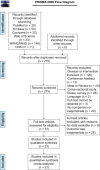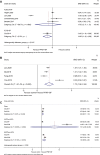Electromyographic Biofeedback for Stress Urinary Incontinence or Pelvic Floor Dysfunction in Women: A Systematic Review and Meta-Analysis
- PMID: 34176082
- PMCID: PMC8342347
- DOI: 10.1007/s12325-021-01831-6
Electromyographic Biofeedback for Stress Urinary Incontinence or Pelvic Floor Dysfunction in Women: A Systematic Review and Meta-Analysis
Abstract
Electromyographic biofeedback (EMG-BF) can be regarded as an adjuvant to pelvic floor muscle (PFM) training (PFMT) for the management of stress urinary incontinence (SUI). This meta-analysis aimed to compare the efficacy of PFMT with and without EMG-BF on the cure and improvement rate, PFM strength, urinary incontinence score, and quality of sexual life for the treatment of SUI or pelvic floor dysfunction (PFD). PubMed, EMBASE, the Cochrane Library, Web of Science, Wanfang, and CNKI were systematically searched for studies published up to January 2021. The outcomes were the cure and improvement rate, symptom-related score, pelvic floor muscle strength change, and sexual life quality. Twenty-one studies (comprising 1967 patients with EMG-BF + PFMT and 1898 with PFMT) were included. Compared with PFMT, EMG-BF + PFMT had benefits regarding the cure and improvement rate in SUI (OR 4.82, 95% CI 2.21-10.51, P < 0.001; I2 = 85.3%, Pheterogeneity < 0.001) and in PFD (OR 2.81, 95% CI 2.04-3.86, P < 0.001; I2 = 13.1%, Pheterogeneity = 0.331), and in quality of life using the I-QOL tool (SMD 1.47, 95% CI 0.69-2.26, P < 0.001; I2 = 90.1%, Pheterogeneity < 0.001), quality of sexual life using the FSFI tool (SMD 2.86, 95% CI 0.47-5.25, P = 0.019; I2 = 98.7%, Pheterogeneity < 0.001), urinary incontinence using the ICI-Q-SF tool (SMD - 0.62, 95% CI - 1.16, - 0.08, P = 0.024), PFM strength (SMD 1.72, 95% CI 1.08-2.35, P < 0.001; I2 = 91.4%, Pheterogeneity < 0.001), and urodynamics using Qmax (SMD 0.84, 95% CI 0.57-1.10, P < 0.001; I2 = 0%, Pheterogeneity = 0.420) and MUCP (SMD 1.54, 95% CI 0.66-2.43, P = 0.001; I2 = 81.8%, Pheterogeneity = 0.019). There was limited evidence of publication bias. PFMT combined with EMG-BF achieves better outcomes than PFMT alone in SUI or PFD management.
Keywords: Electromyographic biofeedback; Meta-analysis; Pelvic floor dysfunction; Pelvic floor muscle training; Stress urinary incontinence.
© 2021. The Author(s).
Figures




Similar articles
-
Conservative interventions for treating urinary incontinence in women: an Overview of Cochrane systematic reviews.Cochrane Database Syst Rev. 2022 Sep 2;9(9):CD012337. doi: 10.1002/14651858.CD012337.pub2. Cochrane Database Syst Rev. 2022. PMID: 36053030 Free PMC article.
-
Pelvic Floor Muscle Training for Urinary Incontinence with or without Biofeedback or Electrostimulation in Women: A Systematic Review.Int J Environ Res Public Health. 2022 Feb 27;19(5):2789. doi: 10.3390/ijerph19052789. Int J Environ Res Public Health. 2022. PMID: 35270480 Free PMC article.
-
A Retrospective Study of Pelvic Floor Muscle Training Combined with Biofeedback Stimulation versus Pelvic Floor Muscle Training Alone in the Treatment of Postpartum Stress Urinary Incontinence.Arch Esp Urol. 2025 Jul;78(6):684-692. doi: 10.56434/j.arch.esp.urol.20257806.92. Arch Esp Urol. 2025. PMID: 40776867
-
Effect of Pelvic Floor Muscle Training Combined with Electrical Stimulation Therapy on Stress Urinary Incontinence: A Meta-Analysis.Urol Int. 2025;109(4):425-435. doi: 10.1159/000543133. Epub 2025 Jan 8. Urol Int. 2025. PMID: 39778553
-
Pressure-Mediated Biofeedback With Pelvic Floor Muscle Training for Urinary Incontinence: A Randomized Clinical Trial.JAMA Netw Open. 2024 Nov 4;7(11):e2442925. doi: 10.1001/jamanetworkopen.2024.42925. JAMA Netw Open. 2024. PMID: 39499517 Free PMC article. Clinical Trial.
Cited by
-
Surface EMG in China: a report on the 2023 surface EMG symposium.Front Rehabil Sci. 2024 Feb 14;5:1353564. doi: 10.3389/fresc.2024.1353564. eCollection 2024. Front Rehabil Sci. 2024. PMID: 38420366 Free PMC article. No abstract available.
-
Holmium laser enucleation of the prostate: Modified urethral mucosa pre-dissected technique versus traditional three-lobe technique-A retrospective study.Lasers Med Sci. 2024 Nov 15;39(1):278. doi: 10.1007/s10103-024-04224-7. Lasers Med Sci. 2024. PMID: 39542933
-
Single Incision Sling Surgery for Female Stress Urinary Incontinence: A Retrospective Cohort Single-Institution Study.J Clin Med. 2024 Aug 20;13(16):4908. doi: 10.3390/jcm13164908. J Clin Med. 2024. PMID: 39201050 Free PMC article.
-
Multi-Regional Pelvic Floor Muscle Function Diagnosis System Based on Inflatable Stretchable Electrode Array.Healthcare (Basel). 2024 Sep 24;12(19):1910. doi: 10.3390/healthcare12191910. Healthcare (Basel). 2024. PMID: 39408090 Free PMC article.
-
The beneficial effects of conservative treatment with biofeedback and electrostimulation on pelvic floor disorders.Tzu Chi Med J. 2023 Sep 22;36(3):291-297. doi: 10.4103/tcmj.tcmj_174_23. eCollection 2024 Jul-Sep. Tzu Chi Med J. 2023. PMID: 38993823 Free PMC article.
References
Publication types
MeSH terms
Associated data
LinkOut - more resources
Full Text Sources
Medical
Miscellaneous

